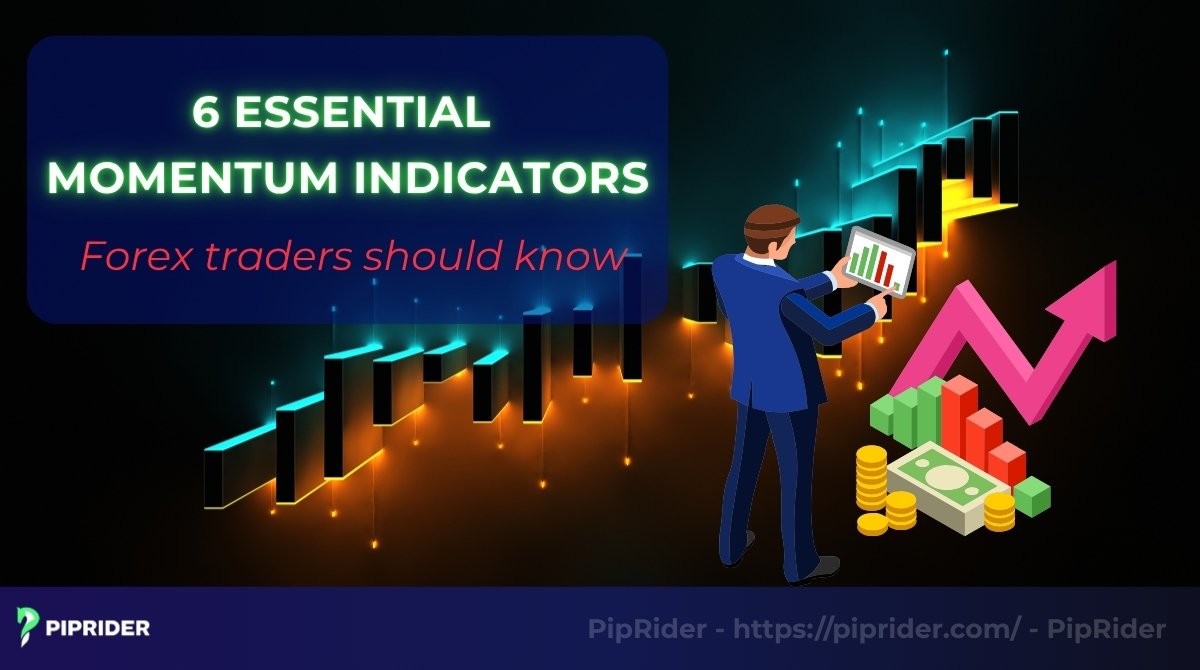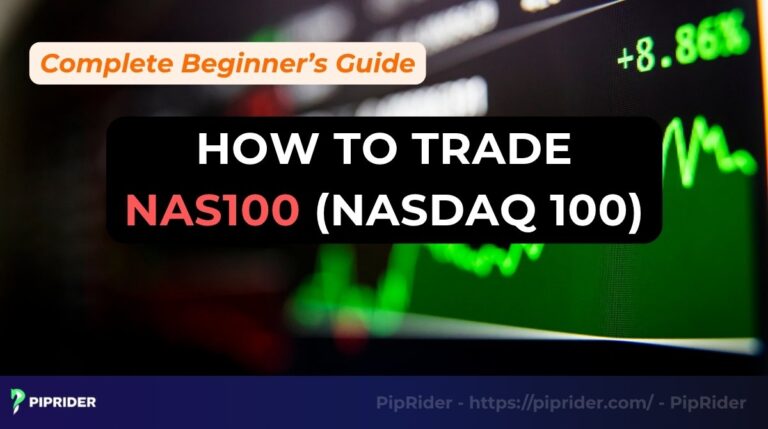Have you ever jumped into what looked like a powerful trend, only to have it run out of momentum the moment you entered? It’s a deeply frustrating experience that every trader has faced. This is where an understanding of market momentum becomes critical.
Momentum indicator acts as a market speedometer, telling you the speed of price movement to help you determine the true strength of a trend.
This guide will introduce you to these tools, explain how they work, and provide practical strategies to help you make better trading decisions.
Key Takeaways
- Momentum tools measure the speed of price changes, helping you assess a trend’s true strength.
- This guide covers 6 top tools, including the RSI, MACD, and Stochastic.
- Their most powerful signals come from identifying overbought/oversold levels, spotting divergences, and confirming trends with crossovers.
- These indicators are confirmation tools and should never be used in isolation.
- The “best” indicator is subjective; the choice depends on your strategy and market conditions.
1. What are momentum indicators?
Momentum indicators are technical analysis tools that measure the rate of price change over a specific period. They show whether a trend is accelerating, holding steady, or weakening (Investopedia, n.d.).
A fundamental principle is that a powerful directional move is supported by accelerating momentum. When this force starts to decline, it is the earliest sign that a market may be running out of steam and could be due for a full market reversal.
This is why these indicators are vital for traders. They help you determine if a fresh movement is strong enough to join, or if a winning trade should be taken for profit. By providing insight into the underlying price direction and its strength, they give you a major advantage in timing your entries and exits.
2. Types of momentum indicators
Not all of these tools are created equal. They fall into two main families, and knowing which one to use is crucial because each is designed for a completely different job.
One family is built for markets moving sideways, while the other excels when the market is in a clear, powerful trend.
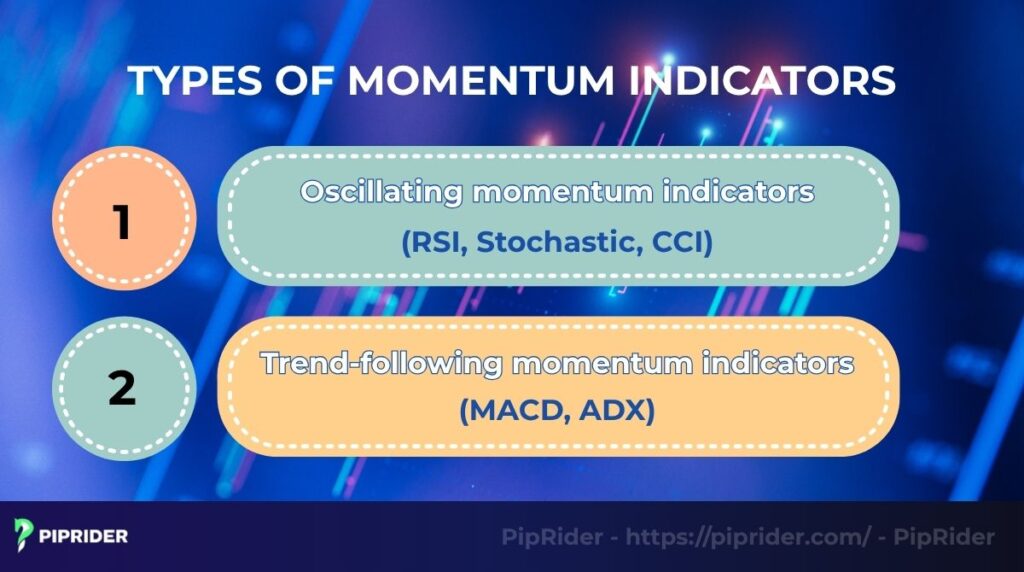
2.1. Oscillating momentum indicators
The first family of indicators is designed to operate within a fixed range, typically from 0 to 100. Because they are bounded, they are perfectly suited for identifying overbought and oversold levels. The goal is to spot when a market has moved too far, too fast, and is due for a reversal. They don’t measure pure trend velocity but rather the health of a trend.
- When to use them: When you’re looking for signs that a market is exhausted and a reversal is likely.
- Examples: The Relative Strength Index (RSI) and the Stochastic Oscillator.
2.2. Trend-following momentum indicators
The second family has no upper or lower limits, instead oscillating above and below a central zero line. Because they are unbounded, they are ideal for measuring raw momentum. Their primary purpose is to confirm trend power and velocity. A rising line above zero indicates that the momentum behind an uptrend is accelerating, while a falling line below zero shows that selling pressure is gaining speed.
- When to use them: When you want to confirm the power of a trend or spot disagreements between price and momentum.
- Examples: The Rate of Change (ROC) and the Moving Average Convergence Divergence (MACD).
Knowing the difference is critical. You wouldn’t use a speedometer to measure how much fuel is left in the tank. Similarly, you wouldn’t use an overbought/oversold indicator to measure a trend’s velocity.
3. The Momentum indicator formula
There isn’t one universal formula for these tools, as each one calculates momentum in its own unique way.
However, understanding the simple original formula is key to grasping the core concept, which will make it much easier to understand all the others.
3.1. The classic momentum formula
The calculation for the most basic momentum indicator, often just called “Momentum”, is beautifully simple:
| Momentum = (Current Closing Price / Closing Price ‘n’ periods ago) x 100 |
This formula creates a line that oscillates around a baseline of 100, which represents zero momentum change (StockCharts, n.d.).
3.2. Step by step guides
Here is a simple, three-step breakdown of how to calculate the momentum indicator.
Step 1: First, it takes today’s price. The calculation starts by taking the most recent closing price of the asset you’re watching, for example, the price of Gold at the end of the day.
Step 2: After that, it looks at a past value. This tool references a rate from a set number of periods in the past, which is what ‘n’ stands for in the formula. A common setting is 14 periods, so it would find the closing value from 14 days ago.
Step 3: Finally, the comparison is made through simple division. The indicator takes the current closing price and divides it by the historical one. A reading above the 100 baseline signifies positive momentum from a rising price, whereas a reading below it indicates negative momentum from a price drop.
You don’t need to memorize the complex math behind indicators like the RSI or MACD. What’s important is to understand this core principle: they are all just comparing today’s price to a past price to measure the force of the move.
4. Top 6 momentum indicators for forex trading
While there are hundreds of indicators out there, most traders find that mastering a select few is far more effective. The following six are the workhorses of momentum analysis; We have used each of them extensively at different points in our trading career.
Let’s break down what they are, what their signals mean, and how to interpret them on a chart.
4.1. RSI (Relative Strength Index)
The RSI is a well-known oscillator that evaluates the speed and degree of price fluctuations, plotting them on a bounded scale from 0 to 100. It is without a doubt one of the most popular momentum tools in the world.

How to read its signals:
- Overbought and oversold: Most traders use the RSI to identify readings above 70 as potentially overbought and readings below 30 as potentially oversold. This does not mean you should immediately sell or buy. It’s simply a warning that the current move may be overextended and due for a pause.
- The 50 centerline: This is a powerful, yet often overlooked, signal. A reading above the 50 level indicates that bullish forces are generally in control. When it’s below 50, bearish momentum is dominant. A cross of the 50 line can often signal a significant shift in trend.
4.2. MACD (Moving Average Convergence Divergence)
The MACD functions as a trend-following momentum tool by showing the interaction and relationship between two distinct exponential moving averages (EMAs). Its purpose is to uncover shifts in a trend’s strength, direction, momentum, and how long it might last.
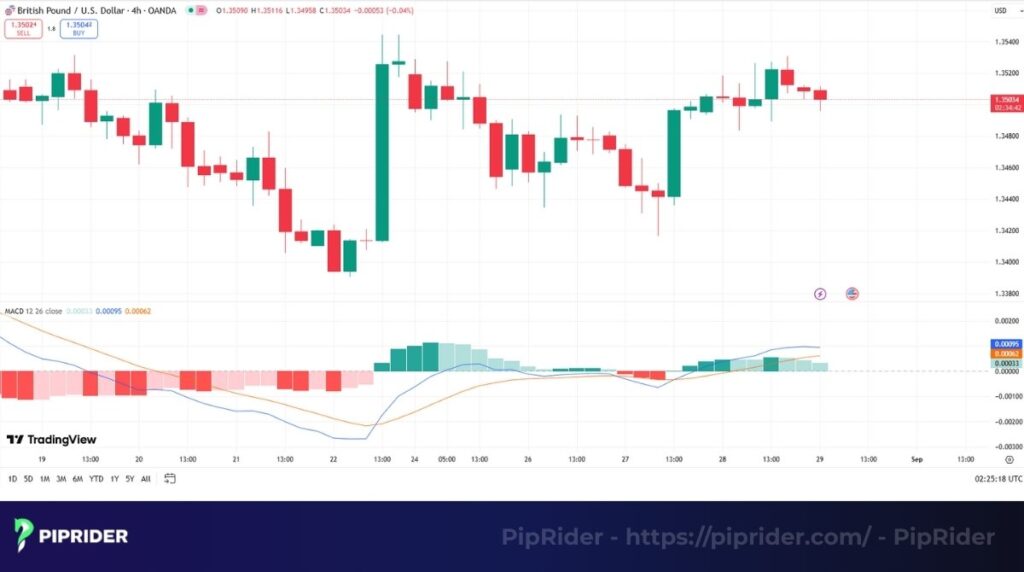
How to read its signals:
- Signal line crossover: This is the most widely recognized signal from this indicator. A bullish signal occurs when its main line (which is faster) moves above its slower counterpart. When it crosses below, it’s a bearish signal.
- Zero line crossover: This signals a more significant, medium-term shift in market control. A move above this central line indicates that bullish forces are taking over, while a drop below it suggests that bearish momentum is now dominant.
- The histogram: Many traders also watch the histogram, which visually represents the distance between the two lines. When the bars grow, momentum is accelerating; when they shrink, it’s a sign that momentum is waning.
4.3. ADX (Average Directional Index)
The ADX is unique because it is designed to measure only the strength of a price trend, not its actual direction. This is a key detail that many newcomers to trading fail to recognize.

How to read its signals:
- The 25 level: When the line is below 25, it indicates a weak trend or a ranging market. In our opinion, this is a great filter to help you avoid trading when there is no clear direction.
- A rising line: When this indicator rises above 25, it confirms that a trend is strengthening and is strong enough to be tradable. If it rises above 40 or 50, it signals an extremely powerful trend.
4.4. CCI (Commodity Channel Index)
The CCI is a versatile oscillator that was originally developed for commodities but is now used in all markets. It measures the current price level relative to an average price level over a specific period.
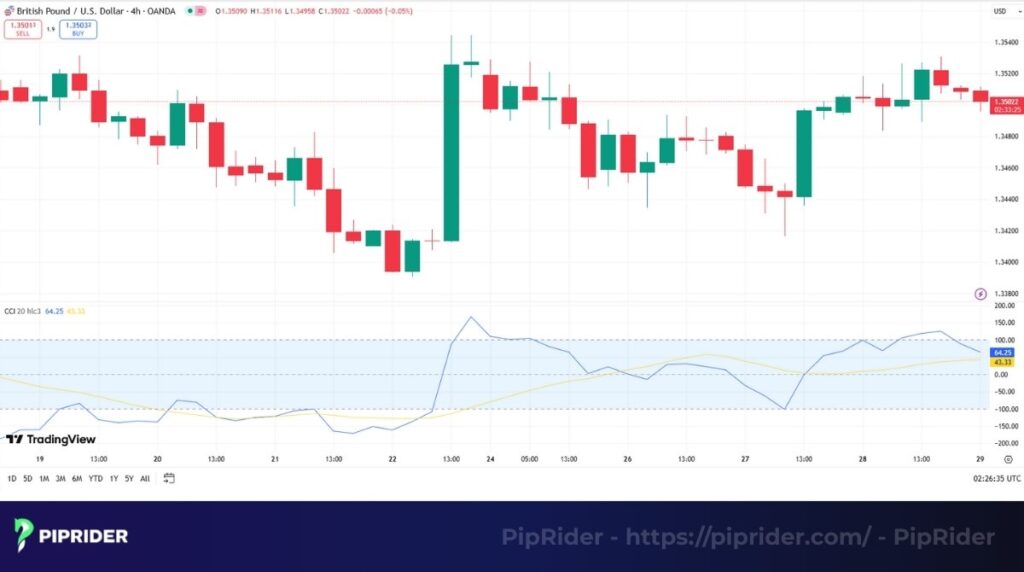
How to read its signals:
- Overbought and oversold: The CCI establishes +100 and -100 as its primary thresholds for identifying extremes. When the indicator surpasses the upper boundary, it’s considered an overbought reading, while a dip below the lower boundary suggests the market has entered an oversold state.
- Disagreement with price: Like the RSI, the CCI is excellent for spotting when the indicator’s movement disagrees with the price, often signaling a potential reversal.
4.5. Stochastic Oscillator
The Stochastic is an oscillator that generates momentum signals by positioning the current closing price within its recent high-low range. Its core idea is that momentum tends to change direction before price.

How to read its signals:
- Overbought and oversold: For the Stochastic, the key levels are typically 80 for overbought and 20 for oversold levels. It tends to be more sensitive than the RSI, making it very popular for identifying short-term turning points, especially in ranging markets.
- Crossover: Similar to other trend tools, a crossover of its two lines (%K and %D) in the overbought or oversold zones is a classic entry signal.
4.6. TRIX (Triple Exponential Average)
TRIX is a powerful momentum indicator that displays the percentage rate of change of a triple exponentially smoothed moving average. Its main advantage is that it filters out insignificant price movement, making it an excellent tool for identifying the main trend.

How to read its signals:
- Zero line crossover: When the indicator’s line climbs above this central point, it generates a compelling buy signal as momentum turns positive. Conversely, a drop below zero is interpreted as a strong signal to sell.
- Disagreement with price: TRIX is also effective at identifying when its movement and the price are out of sync, which can signal an impending trend change.
We realize we’ve covered a great deal of information here. To make it easier, we’ve created this simple table to help you quickly compare these six indicators and decide which one might be the right tool for the specific job you have in mind.
Summary: Choosing the right tool for the job
| Indicator | Primary Purpose | Best for |
| RSI | Gauging price strength & speed | Identifying overbought/oversold levels and divergences. |
| MACD | Revealing momentum via two moving averages | Confirming momentum & highlighting crossover signals. |
| ADX | Isolating strength, not direction | Avoiding range-bound markets; confirming powerful moves. |
| CCI | Finding price extremes vs. its average | Spotting cyclical patterns & extreme price levels. |
| Stochastic | Compares closing price to its recent range | Pinpointing short-term extremes, best in ranges. |
| TRIX | Filtering market noise with a triple-smoothed MA | Signaling major directional shifts with smooth signals. |
5. How to use momentum indicators in forex trading
Knowing what these indicators are is one thing; using them effectively to make trading decisions is an entirely different skill. They are not crystal balls, but when you learn to read their signals correctly, they can dramatically improve your timing and analysis.
Let’s break down the three most important signals you can get from these tools: overbought/oversold levels, crossovers, and divergences.
5.1. Reading overbought and oversold conditions
Reading overbought conditions (or oversold ones) is the primary way traders utilize oscillating indicators like the RSI and Stochastic. Think of these states like a rubber band being stretched; at some point, it’s likely to snap back.
The signal isn’t when the indicator enters an extreme zone (e.g., above 70 on the RSI). That simply tells you the trend is very strong. The real entry or exit signal often occurs when the indicator exits the extreme zone, suggesting that momentum is returning to a more normal level.
5.2. Trading crossover signals
Crossovers are the primary signals for trend-following tools. These signals are straightforward, easy to spot, and offer clear potential action points.
There are two main types you’ll watch for.
- A crossover of the two moving averages can be an early hint of a change in momentum.
- A zero line crossover is often a more powerful, longer-term signal confirming that the overall momentum has shifted from bullish to bearish, or vice versa.
5.3. The power of divergence trading
This is a powerful signal that appears when an indicator fails to confirm the price action. There are two primary forms:
- Bearish divergence: Prices forge a higher high, yet the momentum reading creates a lower high.
- Bullish divergence: Prices form a lower low, but the oscillator prints a higher low.
In both scenarios, this disagreement is a significant clue that the underlying momentum is weakening and the current trend is losing steam, potentially signaling an upcoming reversal.
Piprider’s experience with momentum
After years of staring at these charts, if there’s one lesson we could share about these tools, it’s this: they are like looking in the rearview mirror. They tell you about the force of the very recent past, not what’s guaranteed to happen next.
Our most profitable trades have never come from blindly following an indicator. They have always come when the indicator’s signal simply confirms what we are already seeing in the price action itself, like a bounce off a key support level or a clear trendline break. Treat them as a trusted consultant, not as the one making the final decision.
6. Strategies for using momentum indicators in forex trading
A single indicator is just a tool, not a strategy. A real strategy is a complete system with rules that tells you not just when to get in, but how to confirm your ideas and manage your risk. Let’s build that framework.
6.1. Multiple timeframe analysis: Getting the big picture
Trading on one timeframe is like using a street map without seeing the highway. The framework to fix this is a simple two-step process:
- Identify the main trend: Start on a higher perspective (Daily, H4) to determine the market’s primary direction.
- Pinpoint your entry: Drop down to a lower view (H1, M15) to time your entry with a momentum signal that aligns with that larger direction.
A perfect example: if the daily chart is bullish, you’d patiently wait for an oversold signal on the H1 chart to buy into a pullback. This ensures you’re buying dips in an uptrend, not trying to fight the dominant market flow.
6.2. Combining indicators for confirmation
This is the core of a robust system. You should never, ever rely on a single indicator’s signal. Instead, you wait for multiple, non-correlated indicators to give you the same message. This is called confluence.
Here are some powerful combinations we’ve used:
Trend + Momentum: Use a long-term moving average (like the 200 EMA) to define the trend. Then, use an oscillator like the RSI to time your entry with a pullback. The chart below will show you clearly about this combination.

Momentum + Volatility: Use an indicator like the Stochastic to find an overbought signal, but only enter the trade after a volatility indicator like Bollinger Bands confirms the price is at an extreme. Looking at the chart to understand the combination.
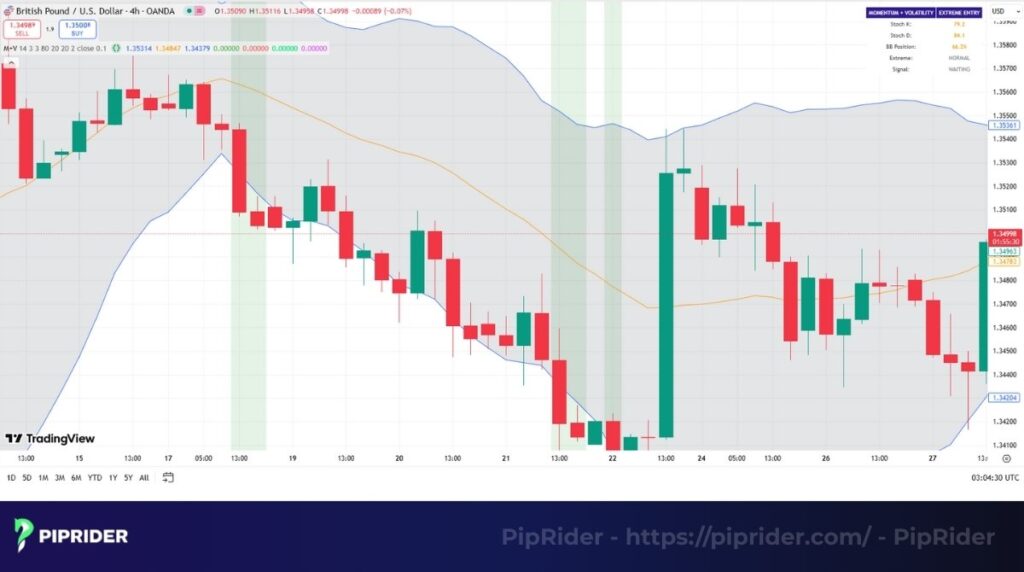
The goal is to have a checklist. You only take a trade if two or three different types of analysis all point to the same conclusion.
6.3. Essential risk management tips
No strategy in the world will save you if you have poor risk management. This is the part of trading that isn’t exciting, but it’s the only thing that will keep you in the game long-term.
- Always use a stop loss. This is non-negotiable. Before you even enter a trade, you must know the exact point at which your idea is proven wrong.
- The 1% rule. We cannot recommend this enough for new traders: never put more than 1% of your entire trading account at risk on any one trade. This means that even if you have a string of losses, you will live to trade another day.
- Know your exit plan. A complete strategy defines your exit points before you even enter. Have a clear idea of where you will take profit, whether it’s at a key resistance level or when your chosen indicator gives an opposing signal.
7. Common mistakes and how to avoid them
Learning what an indicator does is easy. Learning how not to use it is where the real education begins. From our own early mistakes and from mentoring other traders, we’ve found that nearly everyone falls into the same few traps.
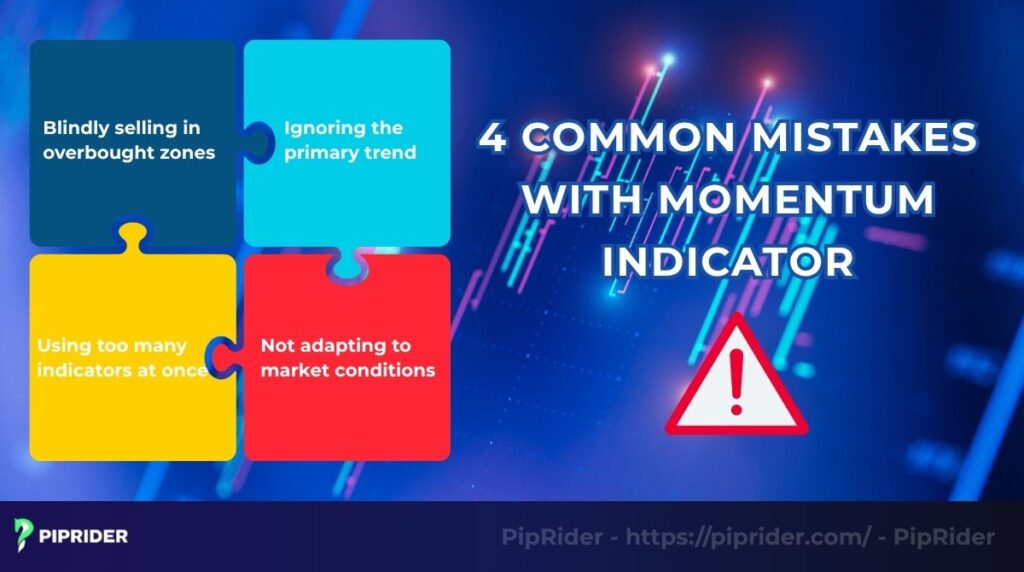
Let’s walk through them so you can avoid the costly learning curve.
7.1. Blindly selling in overbought zones
The most common mistake is selling just because an indicator is “overbought.” In a strong trend, an indicator can remain in an extreme zone for a long time. Wait for the indicator to exit the zone and for a change in price behavior before considering a trade.
7.2. Ignoring the primary trend
A low-probability gamble is trading against the main market direction. The force of a higher timeframe’s trend will almost always overwhelm a conflicting, shorter-term signal. Always start your analysis on a higher timeframe (Daily or H4) and only take trades that align with that direction.
7.3. Using too many indicators at once
This leads to “analysis paralysis.” A cluttered chart with conflicting signals causes confusion and an inability to make a decision. Keep it simple with one indicator for trend, one for momentum, and maybe one for volatility for a cleaner, more effective approach.
7.4. Not adapting to market conditions
No single indicator works in all market conditions. Oscillators (like Stochastic) are best for ranging markets, while trend-followers (like MACD) excel in strong trends. Before you trade, determine if the market is trending or ranging and choose the right tool for the job.
8. Frequently Asked Questions (FAQ)
Here are some quick, straight-to-the-point answers to the questions I hear most often about these tools.
9. Conclusion
Mastering the flow of the market isn’t just about spotting a direction; it’s about understanding the force behind that direction. That is the fundamental power that the tools we’ve discussed today give you. They provide an essential look “under the hood” of what’s happening on the chart, helping you gauge a trend’s health and spot potential turning points before they happen.
But if there is one lesson we hope you take away from this guide, it is this: no single indicator is a complete system. They shine brightest when used to confirm what you are already seeing, not as blind entry signals on their own.
To continue developing your skills, we encourage you to follow us at Piprider and dive into our best technical indicators category. There, you’ll find more advanced strategies and learn new ways to combine tools to get the most out of your momentum indicator.


